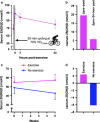Mobilising vitamin D from adipose tissue: The potential impact of exercise
- PMID: 34853551
- PMCID: PMC8609434
- DOI: 10.1111/nbu.12369
Mobilising vitamin D from adipose tissue: The potential impact of exercise
Abstract
Vitamin D is lipophilic and accumulates substantially in adipose tissue. Even without supplementation, the amount of vitamin D in the adipose of a typical adult is equivalent to several months of the daily reference nutrient intake (RNI). Paradoxically, despite the large amounts of vitamin D located in adipose tissue, individuals with obesity are often vitamin D deficient according to consensus measures of vitamin D status (serum 25-hydroxyvitamin D concentrations). Thus, it appears that vitamin D can become 'trapped' in adipose tissue, potentially due to insufficient lipolytic stimulation and/or due to tissue dysfunction/adaptation resulting from adipose expansion. Emerging evidence suggests that exercise may mobilise vitamin D from adipose (even in the absence of weight loss). If exercise helps to mobilise vitamin D from adipose tissue, then this could have important ramifications for practitioners and policymakers regarding the management of low circulating levels of vitamin D, as well as chronically low levels of physical activity, obesity and associated health conditions. This perspective led us to design a study to examine the impact of exercise on vitamin D status, vitamin D turnover and adipose tissue vitamin D content (the VitaDEx project). The VitaDEx project will determine whether increasing physical activity (via exercise) represents a potentially useful strategy to mobilise vitamin D from adipose tissue.
Keywords: 25(OH)D; 25‐hydroxyvitamin D; adipose; exercise; physical activity; vitamin D.
© 2019 The Authors Nutrition Bulletin published by John Wiley & Sons Ltd on behalf of British Nutrition Foundation.
Conflict of interest statement
The authors have no conflict of interest to disclose.
Figures



References
-
- Arunabh S, Pollack S, Yeh J et al. (2003) Body fat content and 25‐hydroxyvitamin D levels in healthy women. The Journal of Clinical Endocrinology and Metabolism 88: 157–61. - PubMed
-
- Askew FA, Bourdillon RB, Bruce HM et al. (1930) The distillation of vitamin D. Proceedings of the Royal Society 107: 76–90.
-
- Baeuerle PA & Baltimore D (1988) IкB: a specific inhibitor of the NF‐кB transcription factor. Science 242: 540–6. - PubMed
Publication types
LinkOut - more resources
Full Text Sources
Other Literature Sources

